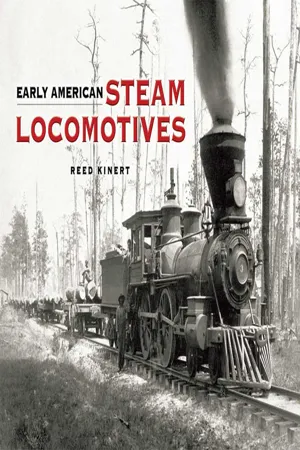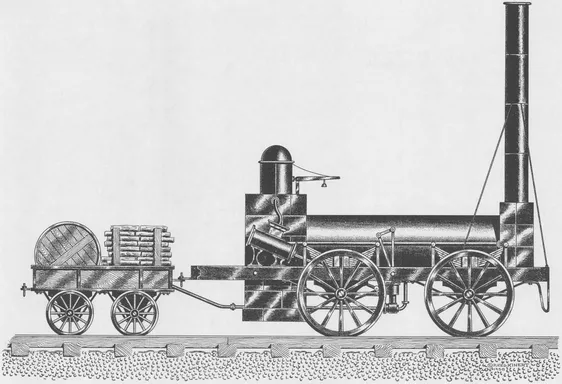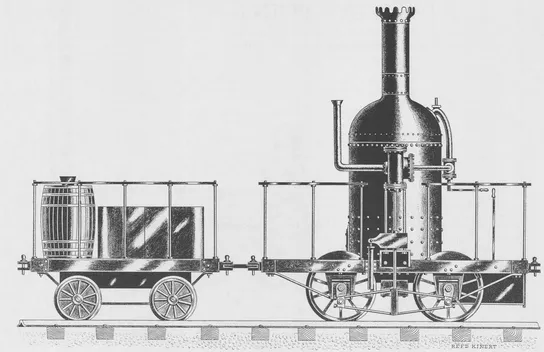![]()
CHAPTER I
AMERICA’S FIRST STEAM LOCOMOTIVE
The first American railroads were powered by horses, just as were the wagons upon the roads and the boats on the canals, and freight and passengers traveled over all three forms of transportation at the same leisurely pace of four miles an hour. But railroads, from the very first, held decided advantages over roads and canals. A horse could, over rails, pull 20 to 30 times more load than he could over a dirt road and while a canal and railroad horse could pull about the same tonnage of freight, the railroad cost a lot less to build and maintain per mile than the canal. The railroad could go anywhere, not being restricted to rather level land like the canals were.
The Baltimore and Ohio Railroad was the first American railway public carrier in regular service. Chartered on February 28, 1827 with plans to connect Baltimore with the boat traffic of the Ohio River some 379 miles westward, at Wheeling, West Virginia, construction began in late 1828 with iron strap rails being doweled or screwed to wood stringers, the stringers then being set in notched ties which were set into a gravel roadbed—and the work was done by carpenters!
While work progressed steadily, it was May 24, 1830 before the horse drawn cars were able to pull into Ellicott’s Mills, only thirteen miles westward. Meanwhile Baltimore business men and the railroad directors had been meeting often, for they grew increasingly worried about the progress of new railroads and canals to the north and south of them. Into such a directors meeting in the fall of 1829 strode Mr. Peter Cooper, a most amazing merchant from New York City who had invested in the lands of a terminal and improvement company in Baltimore. Mr. Cooper too was worried about his investment in Baltimore, as its success hinged very heavily upon the success of the town itself. Mr. Cooper told the directors that he believed steam locomotion might be the answer to their problems and that he believed he could knock together a workable steam locomotive for testing on the rails.
The world’s first practical steam locomotive for use on rails had been built in England by George Stephenson in 1825. Placed on the rails of a horse operated railroad, Stephenson’s engine named Locomotion, with George as engineer, pulled twenty-nine small four-wheeled cars plus a tender loaded with water and coal, and averaged eight miles per hour. Then, early in 1829, four English locomotives were purchased and shipped to northeastern Pensylvania to be used by the Delaware and Hudson Canal Company in hauling coal from it’s Carbondale mines to the canal terminus, sixteen and a half miles east at Honesdale. Upon arrival the locomotives were found to weigh almost seven tons instead of their estimated three tons. Two of the four engines were assembled at the West Point Foundry, New York City, and one of them, the Stourbridge Lion, was tried in August of 1829 on the Delaware & Hudson’s rails but was found to be too rigid for the uneven and sharply curved track in addition to being just too heavy for the flimsily built roadbed. All four locomotives eventually disappeared, the other three apparently never being set on rails. Then in 1905 the boiler and other parts of the celebrated Stourbridge Lion were collected in various parts, sent to the Smithsonian Institute, Washington, D.C., and put together, making, with the addition of a few new pieces, a complete engine. The Baltimore & Ohio directors had investigated the above tests so figured they had nothing to lose by giving Mr. Cooper a chance at building a locomotive. Peter, who owned a foundry and was handy with tools, journeyed to New York and bought a little steam engine with a cylinder three and one-quarter inches by fourteen and one-half inches and, returning to Baltimore, got some iron and built a boiler about as big as an ordinary wash boiler of that day. He wanted some iron pipes for boiler flues but none were obtainable so he used two old musket barrels. Peter went into a coachmakers shop and made his locomotive which he called Tom Thumb because it was so small. He didn’t intend it for actual service but only to show the directors what could be done. He meant to show two things: first, that short turns could be made; and, secondly, that he could get rotary motion without use of a crank. He changed the engines reciprocating movement to a rotary motion by using two gears. To emphasize the fact that the Tom Thumb was developed entirely independent of the English we note the prior invention by Mr. Cooper of two fundamental features later used on all steam locomotives—the multi-tubular boiler and the artificial draft. Cooper’s boiler tubes of musket barrels have been mentioned. The air blast by which he secured a forced draft was obtained by a blower fan worked by a belt from the axle of the engine. Then, later, Stephenson hit upon the correct principle of a forced draft, quite by accident. The exhaust from his first locomotive frightened horses and he was notified by the police that if he kept on with his noisy engines he would be arrested. He turned the exhaust into the smoke-stack to muffle the noise and found to his joy that he had provided a forced draft. It is this latter principle that is in use to this day while Peter Cooper’s blower idea wasn’t used until much later when adapted to supercharge reciprocating gasoline and diesel engines.
Finally the little locomotive was finished, then one Saturday night steam was got up; the president of the road and two or three gentlemen had been anxiously standing by so they and Peter climbed onto Tom Thumb and went out two or three miles towards the west. All were very much delighted and Tom Thumb was put in its shed and all were invited to a daytime ride on Monday—a ride to Ellicott’s Mills. Came Monday and what was their grief and chagrin to find that some scamp had been there and chopped off all the copper from the engine and carried it away. The copper lines that conveyed the steam to the piston was gone. It took Mr. Cooper a week or more to repair the locomotive, which, you may be sure, was placed under guard each night, and then on Saturday, August 28, 1830, with six men on the engine and thirty-six men in an attached car, the Tom Thumb began the first trip by an American-built locomotive. It went up an average grade of eighteen feet to the mile and made the passage to Ellicott’s Mills in an hour and twelve minutes (this included watering and track switching time) and averaged five and one-half miles per hour.
Then, on the return trip from Ellicott’s Mills, an event took place that has been made much of in the history of railroading. It was an interesting trip. The shortest of curves were traversed without materially slackening a speed of fifteen miles an hour. The day was fine, the company in the highest spirits and some excited gentlemen of the party, when the train was at its highest speed, eighteen miles an hour, pulled out their note books and wrote connected sentences just to show that such a thing was possible!
Then Tom Thumb and its gay load of passengers arrived at Relay House, the halfway home point, where it was known the little locomotive would be refueled. The great stage proprietors of the day, Stockton and Stokes, who furnished most of the horses used by the B & O, had contrived to have a gallant grey horse of great beauty and power hitched to an enclosed passenger car standing ready on the second track—for the company had wisely begun by making two tracks to the mills.
Fearful of the steam locomotives eventual success, but still confident of the horses superiority over the engine, Stockton & Stokes had arranged this meeting to prove their point. They and their cohorts jeered and coaxed for a race and Peter Cooper was not unwilling for he felt his little engine to be the master of any horse.
The little TOM THUMB slowly gained on the gallant grey horse then passed him and it seemed that the race was won.
The start being even away went horse and engine, the snort of one and the puff of the other keeping time and tune. At first the grey had the best of it, for his power was applied to the greatest advantage on the instant, while the engine had to wait until rotation of the wheels set the blower to work. The horse was perhaps a quarter of a mile ahead when the safety-valve of the engine lifted and the thin blue vapor issuing from it showed an excess of steam. The blower whistled, the steam blew off in vapory clouds, the pace increased, the passengers shouted. Soon the race was neck and neck, then the engine passed the horse and a great hurrah hailed the victory. But it was not repeated; for just at this time, when the grey’s master was about to give up, the band which drove the pulley which drove the forced-draft blower, slipped from the drum. The safety-valve ceased to scream and the engine, for want of breath, began to wheeze and pant. In vain Mr. Cooper, who was his own engine man and fireman, lacerated his hands in attempting to replace the band upon the wheel; in vain he tried to urge the fire with light wood. The horse gained on the machine and passed it; and although the band was presently replaced and steam again did its best, the horse was too far ahead to be overtaken and so came in the winner.
The victory of the grey horse was short lived and proved to be the last gasp of a mode of transport that was about to expire upon the railroad. The horse and the order of things for which it stood was doomed. Peter Cooper soon fixed the fan belt upon the blower so it wouldn’t slip off and presently was out on the track again. For some weeks the Tom Thumb continued to operate on the railroad, giving demonstrations, and important data was being compiled on the little locomotive which could pull a load of forty-two people up a slight grade with its tiny engine developing but 1.43 horsepower!
THE WEST POINT
2ND LOCOMOTIVE OF THE SOUTH CAROLINA CANAL & RAILROAD CO.
Builder . . . West Point Foundry, New York City . . . 1831
THE YORK
4 WHEEL VERTICAL-BOILERED ENGINE
Builder . . . Davis & Gartner . . . 1831
![]()
CHAPTER II
AMERICA’S SECOND & THIRD STEAM LOCOMOTIVES
While the Baltimore & Ohio Railroad holds the honor of being the first American railway carrier in regular service, steam did not completely displace horse-drawn traffic over that road until several years later. By contrast, the South Carolina Canal & Railroad Company (now part of the Southern Railway) used steam from its beginning. The railway was to be built from Charleston, S.C., thence west northwest to Hamburg, S.C., just across the Savannah River from Augusta, Georgia, the distance of 136 miles.
Work began on the railroad at Charleston January 9, 1830, and iron-strap rails were spiked to wood stringers, the stringers set into wooden cross ties in much the same type construction as used on the B & O.
With the railroad under way, their new chief engineer, Horatio Allen, who had acted as purchasing agent in buying and assisted in assembling of the English locomotives mentioned in chapter I, convinced the railroad directors they should use steam locomotion from the start. With the help of C. E. Detmold, who had invented for the railroad a horse-driven motor worked on an endless chain platform, and E. L. Miller of Charleston, the three men proceeded to design a unique engine. The West Point Foundry of New York was commissioned to build the locomotive since they had gained some experience by assembling the two imported English engines mentioned, under E. L. Miller’s supervision. The foundry built the locomotive which was wisely named Best Friend of Charleston, for $4,000 and on October 23, 1830, it arrived at Charleston aboard the steamship Niagara. Nearly all the townfolk eagerly turned out to get a look at the steam horse which they hoped would make Charleston a great seaport by providing low cost transportation between their port and the fast developing inland areas.
Best Friend was a lightweight, weighing less than four tons and it developed only six horsepower. All four wheels were drivers, motivated by a double crank from two inclined cylinders mounted inside and at the front of the frame, each wheel being connected together with outside rods. The wheels were iron hub, the spokes being made of hard wood and the wheel tires were iron. The boiler was a vertical one, in the form of an old-fashioned porter bottle and looked somewhat like a Coke bottle too. The Best Friend made several short trips upon the rails, then on November 2, 1830, with her engineer Nicholas W. Darrell in charge, a trial trip was made hauling several men in an attached car. In rounding a curve the forward wheels left the rails and the wood-spoked front wheels all but collapsed as the engine rolled to a stop some 20 feet ahead. The two crewmen escaped the accident with some bruises; the men in the following car were uninjured.
More than a month’s repairing was necessary before Best Friend was reworked with iron-spoked wheels and made ready for another unofficial...




